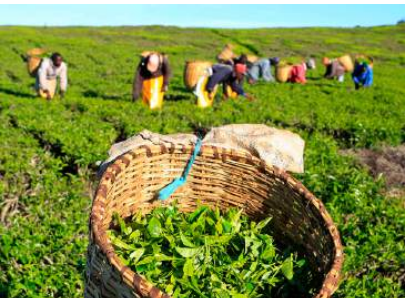
 Tea pickers at
a firm in Nandi
Hills /REUTERS
/NOOR KHAMIS
Tea pickers at
a firm in Nandi
Hills /REUTERS
/NOOR KHAMIS
Sub-Saharan Africa’s economies, including Kenya, remain resilient, with growth projected to average 3.8 per cent across the region in 2025, up from 3.5 per cent in 2024, the World Bank now says.
Kenya’s economy is poised to perform slightly better with a growth projection of 4.5 per cent, on the back of easing inflationary pressures and a modest recovery of investment despite persistent global economic uncertainty, with a projected acceleration to 4.9 per cent on average during 2026-2027.
The number of countries experiencing double-digit inflation has fallen sharply—from twenty-three in October 2022 to 10 in July 2025—signaling progress in stabilizing prices.
According to World Bank, Kenya’s GDP started the year growing by 4.9 per cent year-on-year in the first quarter, thanks to robust performance in agriculture, mining, information and communication, as well as financial services.
Good weather conditions across the country supported the growth of agricultural production (six per cent year-on-year).
Private sector business sentiment contracted in August 2025 but at a slower pace than in July, as the Purchasing Managers' Index (PMI) increased to 49.4 in August, from 46.8 in July.
It further rose to 51.9 per cent in September, and above the 50.0 neutral mark for the first time since April, pointing to a fresh upturn in the health of the private sector, after a period impacted by political protests and rising price pressures.
World Bank in its latest Africa’s Pulse Report has noted that improved performance in the manufacturing, wholesale and retail sectors drove an increase in the PMI despite the softer performance in agriculture, construction, and services.
Kenya National Bureau of Statistics data indicates inflation, the measure of the cost of living, slightly increased to 4.6 per cent in September from 4.5 per cent the previous month, but remained within the target levels of five per cent, a single digit.
Kenya’s Public Finance Review 19 proposes five packages that focus on strengthening governance to rebuild trust in government; carrying out fiscal reforms to boost competitiveness and implementation of the AfCFTA, reforming state-owned enterprises (SOEs), including
KNBS notes that Kenya's economy is
estimated to have expanded by five per cent in the second quarter of 2025,
compared to 4.6 per cent growth during the same quarter of 2024.
World Bank has, however, noted that downside risks loom large, including the indirect effects of global trade policy uncertainty, declining investor appetite and a shrinking pool of external finance, including declining official development assistance in the region, with Kenya not being exceptional.
External debt service has more than doubled over the past decade, reaching two per cent of GDP in 2024. The number of Sub-Saharan African countries in or at high risk of debt distress has nearly tripled, rising from eight in 2014 to twenty-three in 2025—nearly half of the region.
The pace of growth hence remains insufficient to meaningfully reduce extreme poverty or create the quantity and quality of jobs needed to meet the demands of a rapidly growing labour force.
Africa is experiencing the world’s largest and fastest demographic shift. To harness this opportunity, countries must accelerate growth that delivers high-quality jobs—a central theme of the 32nd edition of Africa’s Pulse, the World Bank’s biannual economic update for the region, which this year focuses on Pathways to Job Creation in Africa.
“Over the next quarter century, Sub-Saharan Africa’s working-age population will grow by more than 600 million,” said Andrew Dabalen, World Bank chief economist for the Africa region, “The challenge will be matching this growing population with better jobs, given that only 24 per cent of new workers today land wage-paying jobs. A structural shift toward more medium and large firms is essential to generate wage jobs at scale.”
The report outlines a set of policy priorities to help countries stimulate large-scale job creation. Reducing the cost of doing business is critical to enable businesses to expand and new high growth firms to enter the market, World Bank says.
Policies that target the provision of better infrastructure – energy, digital, transport and human capital and skills development are essential for creating an ecosystem for people and businesses to thrive, it further added.
It has also called for strengthening institutions and governance to ensure stability, curbing corruption and creating a predictable business environment that attracts private sector investment.
Stimulating private sector development in sectors such as agribusiness, mining, tourism, healthcare, and housing and construction will also be key.
For example, for every job created in tourism, an additional 1.5 jobs are generated in related sectors. With the right reforms and investments, Sub-Saharan Africa can unlock its vast employment potential and chart a path toward inclusive and sustainable growth, the global lender noted.
It has backed Kenya’s fiscal policy measures to boost growth and create quality jobs.
Kenya’s Public Finance Review19 proposes five packages that focus on strengthening governance to rebuild trust in government; carrying out fiscal reforms to boost competitiveness and implementation of the AfCFTA, reforming state-owned enterprises (SOEs), including privatisation and enhancing governance in other areas; reforming inefficient and inequitable subsidy programmes to implement targeted support to the poor and leveraging fiscal resources.






![[PHOTOS] Ruto steps out in full military uniform](/_next/image?url=https%3A%2F%2Fcdn.radioafrica.digital%2Fimage%2F2025%2F10%2F2d04e0da-2f18-42ec-b29a-50a39e262249.jpeg&w=3840&q=100)





